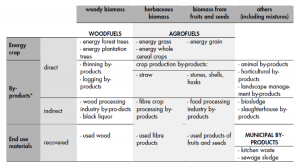by Gaurav Kakkar, kakkarg@vt.edu
The prospects of modernizing the use of biomass and developing cleaner liquid fuels to address concerns of energy cost, security and global warming associated with fossil fuels have led to a greater interest in Biofuels (United Nations, 2008). As classified by the UN (2008), the term biofuel means “any liquid fuel made from plant material that can be used as a substitute to petroleum-derived fuel”. International Energy Agency further adds gaseous fuels from biomass based sources to biofuels (IEA, Bioenergy, 2016). This broad term includes the familiar ones like ethanol made from sugar syrups or diesel like fuel made from plant oils to not so common ones like butanol, di-methyl ether (DME) or Fisher-Tropsch Liquids (FTL) made from lignocellulosic biomass. Moreover, as reported by IEA (2011), biofuels alone have the potential to cover up to 27% of the global transportation fuel requirements by 2050. Thus it is extremely important to understand uniform classification systems of biofuels that are globally adopted and the associated production technology. This article discuss two different classification types of biofuels based upon production technologies and biomass source.
Classification according to generations
There are no strict technical definitions for this classification. The main distinction between them is the feedstock used and associated conversion method used. Following section discuss this classification in detail.
2. First generation: This category includes biofuels produced from conventional, well established processes. These are generally made from sugars, grains, or seeds, i.e. utilize only a specific (often edible) portion of the above-ground biomass produced by a plant. These are often produced with relatively simple processes (United Nations, 2008). Most well-known first generation biofuel is Ethanol produced from fermenting sugars extracted from starch laden crops like sugarcane, sugar beet, corn etc. Using similar processing but a different microbe for fermenting is used to make Butanol.
Pros: Mature technology, familiar feedstock, scalable production capabilities, cost competitive to fossil fuels
Cons: Food vs fuel debate, feedstock price volatility, Low land use efficiency, geographical limitations, modest net reduction in fossil fuel use and greenhouse gas emissions with current processing methods.
2. Second generation: The biofuels produced in this category are generally made from lignocellulosic biomass. This includes either non-edible residues of food crop production (e.g. corn stalks or rice husks) or non-edible whole plant biomass (e.g. grasses or trees grown specifically for energy) (United Nations, 2008). These can be produced from feedstock grown on marginal arable croplands and/or using non-food crops and residues (Biofuels Digest, 2010). These can be further classified based on conversion technology as biochemical and thermochemical. Ethanol is the most common product in this category but competitive production (without subsidies) still needs research (IEA, Bioenergy, 2016).
Pros: Surplus feedstock supply, less controversial, less dependence on geographical location, suitable for developing agrarian countries with large population.
Cons: High capital cost, technological breakthroughs needed, development of high biomass feedstocks to improve land use efficiency.
These two generations of biofuels are the most commonly addressed in academia and industry as of today. Figure 1 summarize production technologies and application of biofuels in replacing petroleum based fuel products.

First and second generation biofuels have inherent limitations preventing them to from becoming a long term alternative to petroleum. Use of food based feedstocks, competition for scare cropland and fresh water, use of fertilizers, seasonality, and population rise are few of the many (Kagan, 2010). Moreover, these fuels cannot be used above small blends without modifying the engines and have no application in Jet fuel market (a large transportation fuel segment) (Kagan, 2010; Aro, 2016). The advanced biofuels, currently is research stage, aim to fulfill this gap. They can further be divided into two generations.
3. Third generation: Biofuels made using non-arable land, based on integrated technologies that produce a feedstock as well as a fuel (or fuel precursor, such as pure vegetable oil), and require the destruction of biomass. These are similar to the 2nd generation fuels but use lot less resources in generating feedstock. Algae is the most promising feedstock candidate in this category which cannot be matched by any other feedstock in terms of quantity or diversity (Biofuel, 2016). This category is under extensive research to reduce production costs and improve metabolic production of fuels (Aro, 2016).
Pros: Only inputs to get feedstock is CO2 and water. Less controversial, versatile array of products possible.
Cons: High capital costs, early research stage
4. Fourth Generation: This category includes biofuels which can be made using non-arable land. These do not require destruction of biomass to be converted to fuel. This technology aims at directly converting available solar energy to fuel using inexhaustible, cheap and widely available resources. They (photobiological solar fuels and electrofuels) are the most advanced biofuels currently under research (Aro, 2016).
Pros: Only inputs to get feedstock is CO2 and water. Less controversial, versatile array of products possible, least negative environmental impact
Cons: High capital costs, early research stage, long processing time. Slow yields
Food and Agricultural Organization (FAO) classification
FAO uses a comprehensive classification based on nature of feedstock and energy content rather than the conversion technology. This classification covers biofuels on the bases of origin of biomass and important trade forms. The aim to develop such system is to assist in recording trades and production stats across the globe (FAO, 2004). FAO classified biofuels into three common groups, namely, Woodfuels, Agrofuels and Municipal By-products. Figure 2 summarize the classification.

Having uniform classification systems are important both for structural innovation and future commercialization of biofuels. Moreover the classification should also be easy to understand and self-explanatory. The two major biofuel classification systems discussed above should help the reader in understanding the global biofuel commercial and underdevelopment market.
References
- Aro, E. (2016). From first generation biofuels to advanced solar biofuels. Ambio, 24-31.
- Biofuel. (2016). Third generation biofuel. Retrieved from Biofuel.org.uk: http://biofuel.org.uk/third-generation-biofuels.html
- Biofuels Digest. (2010, May 18). What are – and who’s making – 2G, 3G and 4G biofuels? Retrieved from Biofuels Digest: http://www.biofuelsdigest.com/bdigest/2010/05/18/3g-4g-a-taxonomy-for-far-out-%E2%80%94-but-not-far-away-%E2%80%94-biofuels/
- FAO. (2004). UNIFIED BIOENERGY TERMINOLOGY. FOOD AND AGRICULTURE ORGANIZATION OF THE UNITED NATIONS.
- IEA. (2011, 4 20). Biofuels can provide up to 27% of world transportation fuel by 2050, IEA report says – IEA ‘roadmap’ shows how biofuel production can be expanded in a sustainable way, and identifies needed technologies and policy actions. Retrieved from International Energy Agency: http://www.iea.org/newsroom/news/2011/april/biofuels-can-provide-up-to-27-of-world-transportation-fuel-by-2050-iea-report-.html
- IEA. (2016, 12 14). Bioenergy. Retrieved from International Energy Agency: http://www.iea.org/topics/renewables/subtopics/bioenergy/
- Kagan, J. (2010). Third and Forth Generation Biofuels: technologies, markets and economics through 2015. GTM Research.
- United Nations. (2008). Biofuel Production Technologies: Status, Prospects and Implicatiopns for trade and development. New York: United Nations Conference on Trade and Development.
